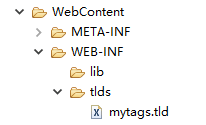当JSTL自带标签无法满足我们的开发需求的时候,我们可以自定义标签。定制标签可以通过实现SimpleTag接口或者继承SimpleTagSupport类(SimpleTagSupport提供了SimpleTag接口默认实现)。
标签的具体实现功能逻辑写在doTag()方法中,定制JSP标签的大致步骤分为两步:
1.编写标签处理器
2.注册标签
SimpleTag
标签处理器
编写一个Java类,实现SimpleTag接口:
1 | public class MyFirstTag implements SimpleTag{ |
doTag方法中编写了定制标签要实现的功能。getParent,setParent方法只有标签嵌套在另一个标签的时候才被调用。setJspContext方法传递了一个JspContext对象,JspContext对象的getOut方法返回一个JspWriter。
注册标签
在WEB-INF文件夹下新建一个tlds文件夹,然后在该文件夹下新建一个mytags.tld文件:

1 |
|
最主要的为tag标签,name标签名,tag-class为标签java类路径。
在jsp页面中使用该标签:
1 | <%@ taglib uri="/WEB-INF/tlds/mytags.tld" prefix="mt"%> |
启动tomcat访问该jsp,页面显示This is my first tag. 控制台输出doTag。
SimpleTagSupport
另一种方法为继承SimpleTagSupport类,重写doTag方法,这里模拟一个时间格式化标签:
1 | public class DateFormatTag extends SimpleTagSupport{ |
fmt为标签的属性,这里为时间格式化的格式。通过静态方法getJspContext可以获取JspContext对象。
编写好便签处理器后,注册它:
1 | <tag> |
attribute标签定义了标签的属性。
在jsp页面中进行测试:
1 | <%@ taglib uri="/WEB-INF/tlds/mytags.tld" prefix="mt"%> |
两种方式给fmt属性赋值,启动tomcat访问该jsp页面,页面显示:

JspFragment
JspFragment就是一段不包含scriplet的jsp代码段,JspFragment类有两个方法:getJspContext和invoke。
getJspContext方法返回与这个JspFragment相关的JspContext,invoke方法用来执行片段,如果片段不含标签无需执行的话,则传递null。
现定制一个select标签,任务是根据传入的以逗号分隔的字符串转为对应的下拉选框。select标签里的JspFragment内容为:
1 | <option value="${value}">${text}</option> |
编写标签处理器:
1 | public class SelectTag extends SimpleTagSupport{ |
注册该标签:
1 | <tag> |
因为标签包含JspFragment,所以body-content标签配置为scriptless。
在jsp页面中测试该标签:
1 | <%@ taglib uri="/WEB-INF/tlds/mytags.tld" prefix="mt"%> |
启动tomcat,访问该jsp页面,页面显示:

查看源码:
1 | <select> |
函数
假如JSTL中的函数标签不能满足我们的实际需求,我们也可以自己编写。
新建Function包,在包下创建StringFunction类:
1 | public class StringFunction { |
注册该标签:
在WEB-INF下的tlds下新建function.tld:
1 |
|
name表示函数名。
function-class为实现该函数的Java类的全类名。
function-signature表示该函数的静态Java方法签名。
在jsp中测试该EL函数:
1 | <%@ taglib uri="/WEB-INF/tlds/function.tld" prefix="fn"%> |
启动tomcat,访问该jsp,页面显示:


